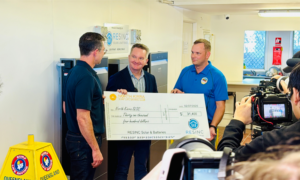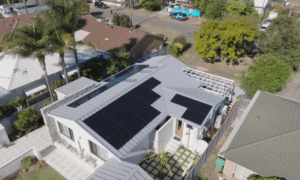A massive synchronous condenser imported for use at Kiamal Solar Farm in Victoria marks a new era for renewable energy integration in Australia.
The Kiamal Solar Farm near Ouyen in north-western Victoria, should begin operation at the end of the year.
Measuring 55 x 65 metres, the new Siemens synchronous condenser solves the problem of how to keep a constant, safe level of current in transmission lines. This problem is especially true where large amounts of power from solar and wind are added – as in north-western Victoria.

What is a synchronous condenser?
A synchronous condenser connects to the electricity grid. It detects when current is lagging or getting too high and corrects the difference.
Synchronous condensers go back to the birth of electricity networks, although other solutions since supplanted them.
However, now that wind and solar farms are supplying electricity generation, synchronous condensers are making a comeback.
Why are they making a comeback?
The technology is reviving because our grid’s transmission lines were designed to work with a constant current coming from a coal-fired power station often hundreds of kilometres away.
In addition, coal-fired turbines are synchronous generators. Synchronous generators have turbines that rotate in sync with the voltage and frequency they generate. This means they feed a steady electrical flow into the grid. And having relatively few of them – compared to all the wind and solar farms we have now – meant the grid was much easier to control in the past.
Wind and solar farms are not synchronous generators – they feed more or less electricity into the grid depending on the wind or sunlight available.
This affects line voltage and therefore the transmission of electricity. Too much voltage and the network could shut down, especially in remote areas where it cannot handle large currents.
Problems for transmission in regional areas
Problems therefore occur when you put solar or wind farms in these remote locations. The addition of this renewables-generated electricity is causing problems in the smooth flow of power; after all, the network is used to handling power from one big power station far away, not several smaller ones built in the local area.
In some remote areas, the networks are not strong enough to handle the power that new wind and solar generators could offer. This is putting a dampener on investment in solar and wind farms. Because if you can’t transmit your solar farm’s power to customers, what’s the point of building one?
Synchronous condensers solve part of the problem – the fluctuating current that renewables put into the grid. They do this by absorbing or boosting transmission line levels as needed. This stops the lines from short-circuiting and cutting out if there’s suddenly too much power, for example.
Grid operator: renewable energy integration needed
The Australian Electricity Market Operator has warned repeatedly that Australia needs to invest in more regional transmission networks as solar and wind farm investment continues.
The need to connect these renewable generators is growing. It will become critical over the next two decades as coal-fired stations reach the end of their lives.
The Kiamal Solar Farm synchronous condenser is a milestone. It’s the first time an Australian solar farm has added such a machine. It will make a solid contribute to the security and reliability of the local network for decades to come.












































